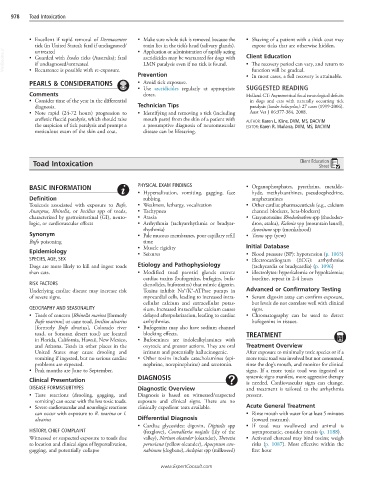Page 1954 - Cote clinical veterinary advisor dogs and cats 4th
P. 1954
978 Toad Intoxication
• Excellent if rapid removal of Dermacentor • Make sure whole tick is removed because the • Shaving of a patient with a thick coat may
toxin lies in the tick’s head (salivary glands).
tick (in United States); fatal if undiagnosed/ • Application or administration of rapidly acting expose ticks that are otherwise hidden.
VetBooks.ir • Guarded with Ixodes ticks (Australia); fatal ascridicides may be warranted for dogs with Client Education
untreated
• The recovery period can vary, and return to
LMN paralysis even if no tick is found.
if undiagnosed/untreated
• Recurrence is possible with re-exposure.
function will be gradual.
Prevention • In most cases, a full recovery is attainable.
PEARLS & CONSIDERATIONS • Avoid tick exposure.
• Use ascridicides regularly at appropriate SUGGESTED READING
Comments doses. Holland CT: Asymmetrical focal neurological deficits
• Consider time of the year in the differential in dogs and cats with naturally occurring tick
diagnosis. Technician Tips paralysis (Ixodes holocyclus): 27 cases (1999-2006).
• Note rapid (24-72 hours) progression to • Identifying and removing a tick (including Aust Vet J 86:377-384, 2008.
areflexic flaccid paralysis, which should raise mouth parts) from the skin of a patient with AUTHOR: Karen L. Kline, DVM, MS, DACVIM
the suspicion of tick paralysis and prompt a a presumptive diagnosis of neuromuscular EDITOR: Karen R. Muñana, DVM, MS, DACVIM
meticulous exam of the skin and coat. disease can be lifesaving.
Toad Intoxication Client Education
Sheet
BASIC INFORMATION PHYSICAL EXAM FINDINGS • Organophosphates, pyrethrins, metalde-
• Hypersalivation, vomiting, gagging, face hyde, methylxanthines, pseudoephedrine,
Definition rubbing amphetamines
Toxicosis associated with exposure to Bufo, • Weakness, lethargy, vocalization • Other cardiac pharmaceuticals (e.g., calcium
Anaxyrus, Rhinella, or Incilius spp of toads, • Tachypnea channel blockers, beta-blockers)
characterized by gastrointestinal (GI), neuro- • Ataxia • Grayanotoxins: Rhododendron spp (rhododen-
logic, or cardiovascular effects • Arrhythmia (tachyarrhythmia or bradyar- dron, azalea), Kalmia spp (mountain laurel),
rhythmia) Aconitum spp (monkshood)
Synonym • Pale mucous membranes, poor capillary refill • Taxus spp (yew)
Bufo poisoning time
• Muscle rigidity Initial Database
Epidemiology • Seizures • Blood pressure (BP): hypotension (p. 1065)
SPECIES, AGE, SEX • Electrocardiogram (ECG): arrhythmias
Dogs are more likely to kill and ingest toads Etiology and Pathophysiology (tachycardia or bradycardia) (p. 1096)
than cats. • Modified toad parotid glands excrete • Electrolytes: hyperkalemia or hypokalemia;
cardiac toxins (bufogenins, bufagins, bufa- baseline, repeat in 2-4 hours
RISK FACTORS dienolides, bufotoxins) that mimic digoxin.
+
+
Underlying cardiac disease may increase risk Toxins inhibit Na /K -ATPase pumps in Advanced or Confirmatory Testing
of severe signs. myocardial cells, leading to increased intra- • Serum digoxin assay can confirm exposure,
cellular calcium and extracellular potas- but levels do not correlate well with clinical
GEOGRAPHY AND SEASONALITY sium. Increased intracellular calcium causes signs.
• Toads of concern (Rhinella marina [formerly delayed afterpolarization, leading to cardiac • Chromatography can be used to detect
Bufo marinus] or cane toad, Incilius alvarius arrhythmias. bufogenins in tissues.
[formerly Bufo alvarius], Colorado river • Bufogenins may also have sodium channel
toad, or Sonoran desert toad) are located blocking effects. TREATMENT
in Florida, California, Hawaii, New Mexico, • Bufotenines are indolealkylamines with
and Arizona. Toads in other places in the oxytocic and pressor actions. They are oral Treatment Overview
United States may cause drooling and irritants and potentially hallucinogenic. After exposure to minimally toxic species or if a
vomiting if ingested, but no serious cardiac • Other toxins include catecholamines (epi- more toxic toad was involved but not consumed,
problems are expected. nephrine, norepinephrine) and serotonin. rinse the dog’s mouth, and monitor for clinical
• Peak months are June to September. signs. If a more toxic toad was ingested or
Clinical Presentation DIAGNOSIS systemic signs manifest, more aggressive therapy
is needed. Cardiovascular signs can change,
DISEASE FORMS/SUBTYPES Diagnostic Overview and treatment is tailored to the arrhythmia
• Taste reactions (drooling, gagging, and Diagnosis is based on witnessed/suspected present.
vomiting) can occur with the less toxic toads. exposure and clinical signs. There are no
• Severe cardiovascular and neurologic reactions clinically expedient tests available. Acute General Treatment
can occur with exposure to R. marina or I. • Rinse mouth with water for at least 5 minutes
alvarius Differential Diagnosis (toward rostrum).
• Cardiac glycosides: digoxin, Digitalis spp • If toad was swallowed and animal is
HISTORY, CHIEF COMPLAINT (foxglove), Convallaria majalis (lily of the asymptomatic, consider emesis (p. 1188).
Witnessed or suspected exposure to toads due valley), Nerium oleander (oleander), Thevetia • Activated charcoal may bind toxins; weigh
to location and clinical signs of hypersalivation, peruviana (yellow oleander), Apocynum can- risks (p. 1087). Most effective within the
gagging, and potentially collapse nabinum (dogbane), Asclepias spp (milkweed) first hour
www.ExpertConsult.com

